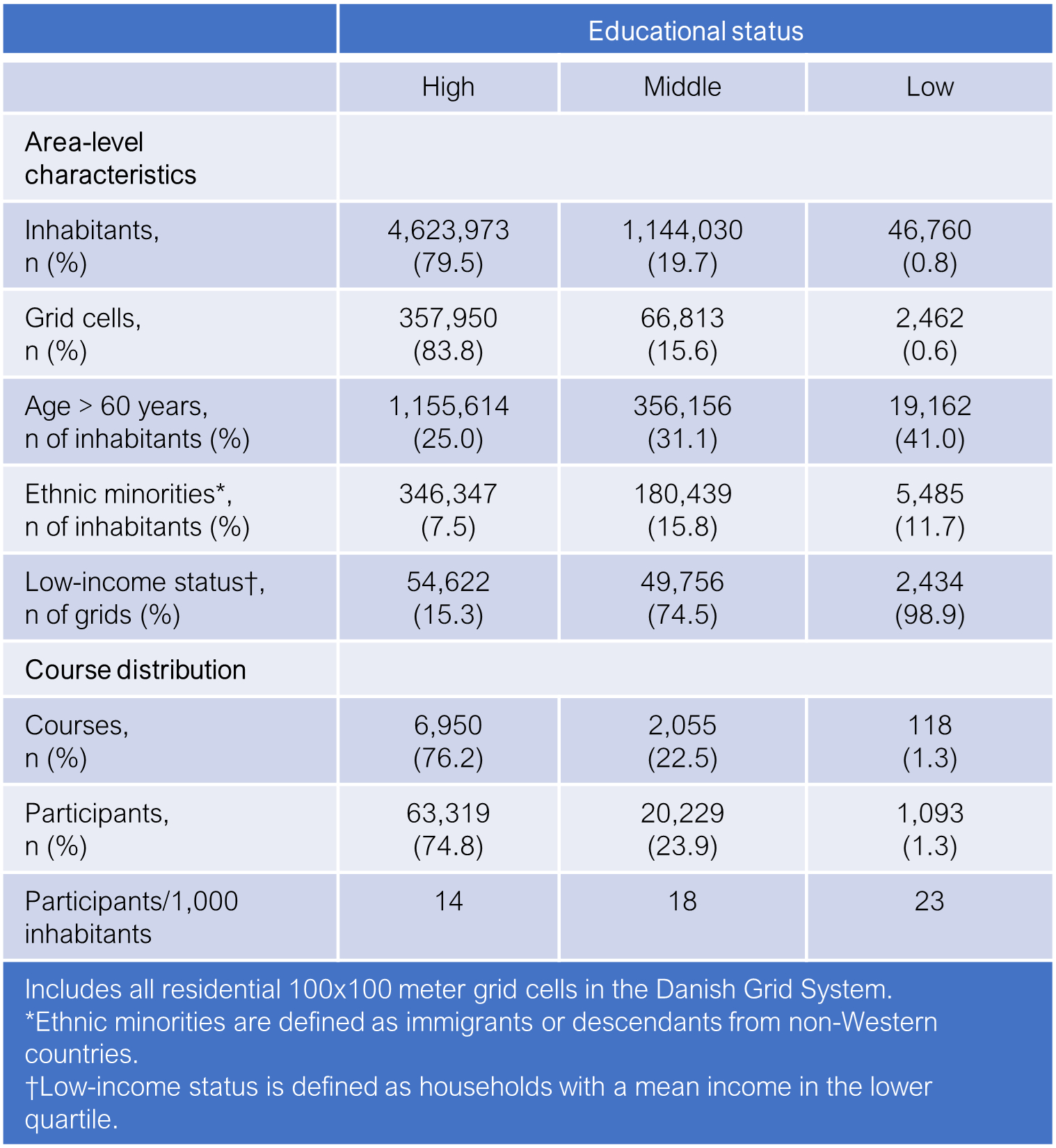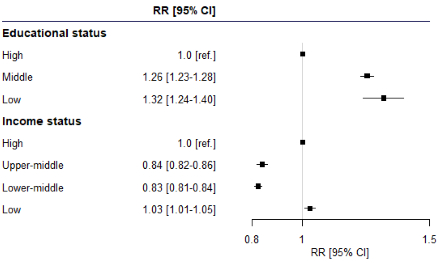Final ID: Sa1207
Reducing Socioeconomic Disparities in Out-of-Hospital Cardiac Arrests in Denmark through 30-minute, Cost-free Cardiopulmonary Resuscitation Courses
Abstract Body: Background: The Danish Heart Foundation has offered 30-minute, cost-free, and easily accessible Save-a-Life courses to disseminate CPR training since 2017.
Research question: Can Save-a-Life courses effectively reach neighbourhoods with low socioeconomic status and reduce socioeconomic disparities in OHCA?
Aim: To investigate the distribution of Save-a-Life courses according to area-level educational or income status.
Methods: We included Save-a-Life courses in residential areas in Denmark (2017-2023). Save-a-Life courses were geocoded using QGIS3 and merged with demographic data organized within 100x100 meter grid cells from the Danish Grid System (2020). Data were provided by the Danish Heart Foundation and Statistics Denmark. Socioeconomic status was assessed by 1) area-level educational status, defined as the percentage of inhabitants with primary or lower secondary school as their highest education (High: 0-25%, Middle: 25-50%, Low: 50-100%), and 2) area-level income status, defined as mean household income divided into quartiles (High, Upper-middle, Lower-middle, Low). We compared course participation (participants/1,000 inhabitants) by educational or income status using a Poisson regression model, presented as risk ratio (RR). Educational status was adjusted for age and ethnicity, while income status was adjusted for age, educational status, and ethnicity.
Results: A total of 9,123 Save-a-Life courses with 84,641 participants were included, covering 426,225 grid cells with 5,814,763 inhabitants. Areal-level characteristics and distribution of Save-a-Life courses are shown in Tables 1 and 2.
Areas with high educational status had 14 participants/1,000 inhabitants (RR=1, reference); middle had 18 participants/1,000 inhabitants (RR=1.26, 95% CI 1.23-1.28); and low had 23 participants/1,000 inhabitants (RR=1.32, 95% CI 1.24-1.4).
Areas with high income status had 14 participants/1,000 inhabitants (RR=1, reference), upper-middle had 12 participants/1,000 inhabitants (RR=0.84, 95% CI 0.82-0.86), lower-middle had 13 participants/1,000 inhabitants (RR=0.83, 95% CI 0.81-0.84), and low had 16 participants/1,000 inhabitants (RR=1.03, 95% CI 1.01-1.05).
Conclusion: Areas with low educational or income status had higher course participation compared to high-status areas. This indicates that the distribution strategy for Save-a-Life courses effectively reach neighborhoods with low socioeconomic status, potentially mitigating socioeconomic disparities in OHCA.
Research question: Can Save-a-Life courses effectively reach neighbourhoods with low socioeconomic status and reduce socioeconomic disparities in OHCA?
Aim: To investigate the distribution of Save-a-Life courses according to area-level educational or income status.
Methods: We included Save-a-Life courses in residential areas in Denmark (2017-2023). Save-a-Life courses were geocoded using QGIS3 and merged with demographic data organized within 100x100 meter grid cells from the Danish Grid System (2020). Data were provided by the Danish Heart Foundation and Statistics Denmark. Socioeconomic status was assessed by 1) area-level educational status, defined as the percentage of inhabitants with primary or lower secondary school as their highest education (High: 0-25%, Middle: 25-50%, Low: 50-100%), and 2) area-level income status, defined as mean household income divided into quartiles (High, Upper-middle, Lower-middle, Low). We compared course participation (participants/1,000 inhabitants) by educational or income status using a Poisson regression model, presented as risk ratio (RR). Educational status was adjusted for age and ethnicity, while income status was adjusted for age, educational status, and ethnicity.
Results: A total of 9,123 Save-a-Life courses with 84,641 participants were included, covering 426,225 grid cells with 5,814,763 inhabitants. Areal-level characteristics and distribution of Save-a-Life courses are shown in Tables 1 and 2.
Areas with high educational status had 14 participants/1,000 inhabitants (RR=1, reference); middle had 18 participants/1,000 inhabitants (RR=1.26, 95% CI 1.23-1.28); and low had 23 participants/1,000 inhabitants (RR=1.32, 95% CI 1.24-1.4).
Areas with high income status had 14 participants/1,000 inhabitants (RR=1, reference), upper-middle had 12 participants/1,000 inhabitants (RR=0.84, 95% CI 0.82-0.86), lower-middle had 13 participants/1,000 inhabitants (RR=0.83, 95% CI 0.81-0.84), and low had 16 participants/1,000 inhabitants (RR=1.03, 95% CI 1.01-1.05).
Conclusion: Areas with low educational or income status had higher course participation compared to high-status areas. This indicates that the distribution strategy for Save-a-Life courses effectively reach neighborhoods with low socioeconomic status, potentially mitigating socioeconomic disparities in OHCA.
More abstracts on this topic:
Active Decompression during Automated Head-up Cardiopulmonary Resuscitation
Pourzand Pouria, Metzger Anja, Moore Johanna, Suresh Mithun, Salverda Bayert, Hai Hamza, Kaizer Alexander, Duval Sue, Bachista Kerry, Lurie Keith
Barriers and Recommendations to Improve Engagement in Workplace Health Programs for Low-Wage Hospital WorkersRowley Christina, Hernandez Mozo Eduardo, Jimenez Rebeca, Cruz Anali, Fortmann Adelaide, Lerner Debra, Adler David, Thorndike Anne, Mccurley Jessica



